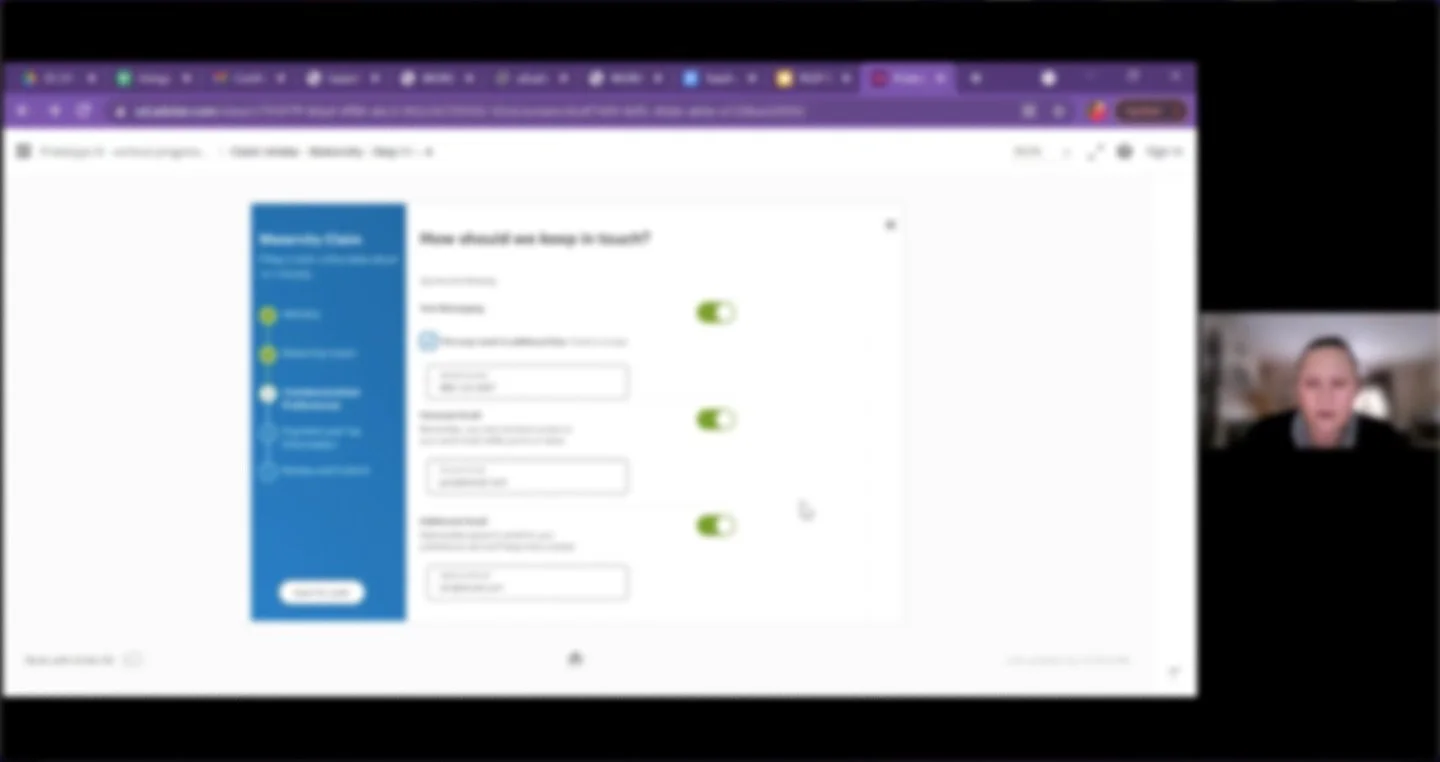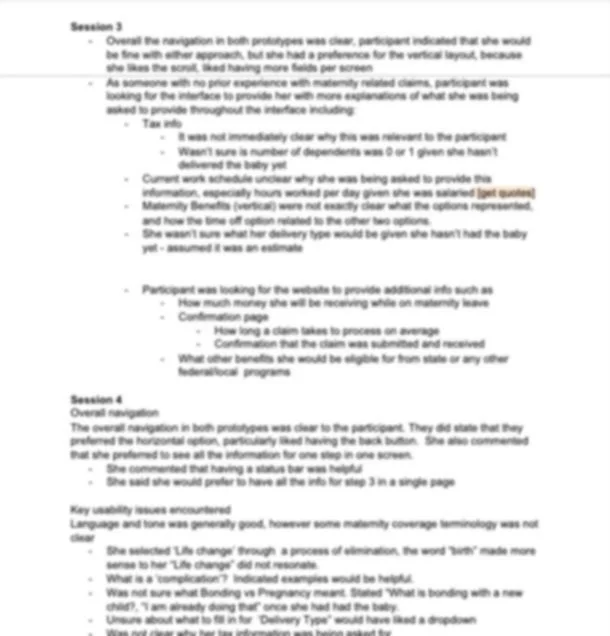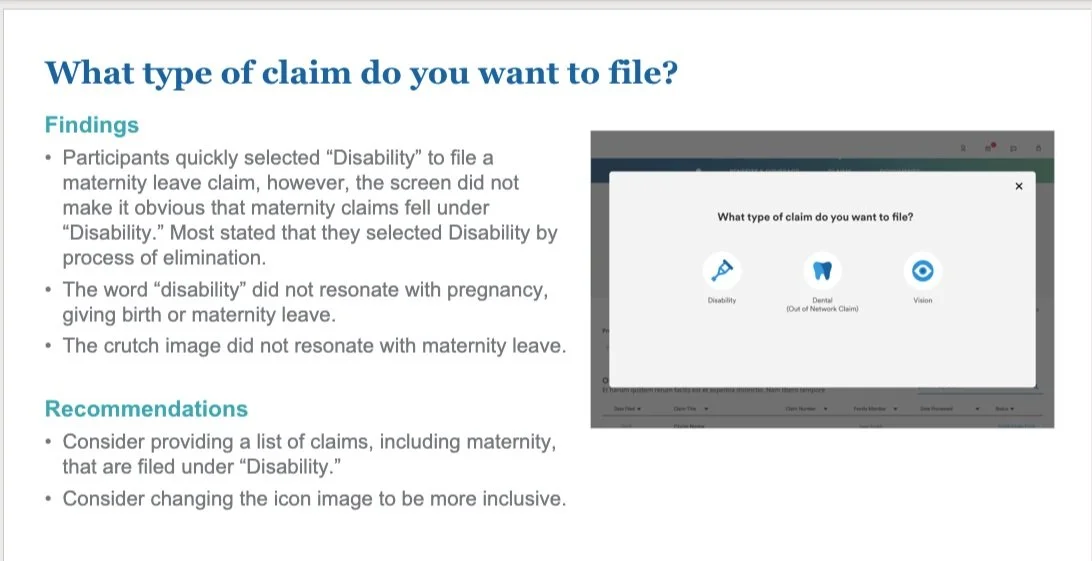
Simplifying Maternity Leave Claims
A comparative usability study for an insurance company, a client of The User Experience Center (UXC).
Project Summary
Setting up maternity leave can be a difficult and confusing process. We partnered with a major insurance company to simplify the claims. We were presented with two different maternity leave flows and over a 6-day period, we scoped out the study, designed and conducted a comparative usability test with expectant mothers, synthesized our findings, and presented a formal report. We put special focus on improving the content strategy and finding opportunities for educating expectant parents on additional benefits. We offered insights that could be used by the client’s design teams to inform their next sprints.
The Challenge
This study, from start to finish, needed to be completed in a short amount of time: 6 days total. We approached this work from an extremely organized and efficient standpoint, accounting for each hour, while still delivering the kind of high quality work expected from the User Experience Center. Below is our condensed timeline.
The timeline of this study.
Role and Responsibilities
I acted as a UX researcher on a team of 3. My responsibilities included:
Scoping and designing the study along with my colleagues
Developing the moderator guide for the study along with my colleagues
Moderating all usability sessions
Synthesizing the findings of the study along with my colleagues
Developing recommendations
Putting together the report along with my colleagues
The Process
1.Scoping the Study
The client came to us wanting to compare 2 maternity leave claims flows:
A horizontal form that moved from screen to screen for each section
A vertical scrolling form with a more conversational feel
We took extremely detailed notes during our kickoff meeting and asked as many questions as possible.
2. Designing the Study
We recruited 6 women who were either planning on taking maternity leave within the next 2 years or had recently been on maternity leave. We designed the formative usability study to be within-subjects, with the first 3 participants going through the form prototype first and then the vertical scroll, and flipping the order for the other 3 participants. We hoped this would reduce bias during their comparison. All sessions were conducted remotely, by me, over Zoom.
3. Developing the Moderator’s Guide
Our notes from the kickoff meeting were so detailed, that we were able to copy them over to the moderator’s guide, practically verbatim. We did this immediately after the kickoff meeting so that their comments were still fresh in our minds. We sent the draft to our client by the end of the same day. By the next afternoon, the client had reviewed the moderator’s guide and came back with additional questions and comments. We quickly addressed those and finalized the moderator’s guide by the end of the day after conducting an internal pilot test.
A page from the final version of the moderator’s guide.
4. Conducting the Usability Tests
We were extremely organized in how we scheduled the usability tests - 4 sessions on day 1 and 2 sessions on day 2. We scheduled each session so there was an hour break in between. Immediately after each session, we would meet as a team to debrief and discuss the session.
First we asked them some background questions to understand their experience and knowledge on maternity claims.
Then we had them go through one of the claims flows. We asked that they think-out-loud as they went through it, with no probing from us, except to remind them to think out loud. Once they finished filing a claim, we went back through each screen to ask questions on anything they may have missed or not commented on initially. We repeated this exercise with the other maternity claim flow.
At the end of the session, we asked them to share their overall impressions of both flows and to let us know which they prefer and why. We also wanted to understand how the more conversational flow felt for the participants.
Knowing that maternity claims can be confusing and complicated to file - we asked if having additional information such as an FAQ or links to other benefits may be helpful.
One of our participants going through the maternity leave claims process.
5. Analyzing the Findings
Because we needed a quick turnaround in delivering the report, analysis had to done in a quick and dirty way. During the debriefs, we worked together as a team to create a summary for each session while it was still fresh in our minds (are you noticing a theme here?). We focused on overall navigation, any usability issues that came up, their preferences, and any other interesting comments. Very quickly, we started noticing patterns in how our participants felt about the 2 prototypes. These debriefing sessions lasted around 15 minutes.
Quick and dirty summary notes after each session helped us gather insights while still conducting usability testing.
6. Reporting the Findings
At the UXC, we present findings through readouts on a slide deck. Immediately after finishing the usability sessions, we started to populate the slide deck with our findings. Because the sessions were still fresh in our minds and we had concise summaries for each session, we were able to pull together the deck in just a few hours. The deck included:
Executive summary
Findings from each screen of both prototypes
Participant preferences for both prototypes
Participant feelings about the tone and language used in the conversational flow
Participant feelings about receiving more information about maternity benefits
A slide from the final report.
Outcomes
The client design team was very happy with our insights and the speed at which we completed this study. They commented that the study results were helpful as they moved forward in their next design sprints.
Reflections
I’m extremely proud of the quality of work we were able to present considering the condensed timeline of this study. I learned later that studies of this scope usually took 2 month to complete. With my team and the client team being extremely organized and clear about expectations, we were able to produce valuable insights in just a few days!
One of the things I love about doing UX research is the learning curve when presented with a brand new project. I have never filed a maternity claim before and had no idea what the process entailed. Working on this study, I learned a lot about how maternity leave in the US works and the different kinds of benefits that are available to expectant parents. I found a lot of satisfaction in helping ease a complicated and confusing process.
After finishing this study, I went through the moderator’s guide and reflected on my lessons learned throughout conducting the sessions. Were any of my questions unclear? Were participants confused on the tasks asked of them? I made updates to the moderator’s guide in how I would reword certain questions to make them more clear to participants. This exercise was helpful in making changes to my own process for future usability studies.





